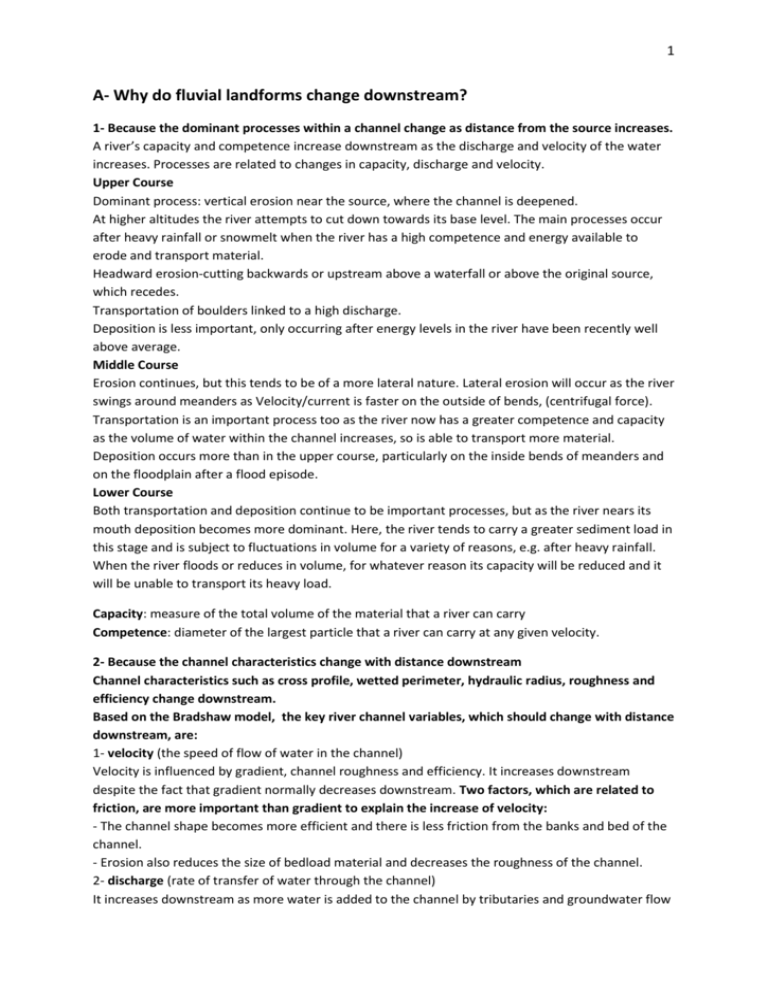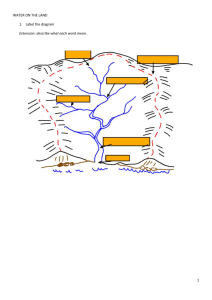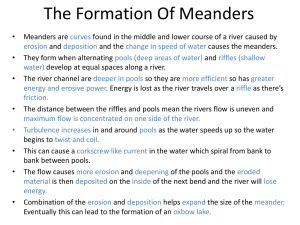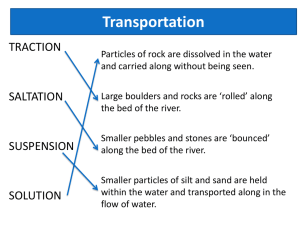All you need to know for the test
advertisement

1 A- Why do fluvial landforms change downstream? 1- Because the dominant processes within a channel change as distance from the source increases. A river’s capacity and competence increase downstream as the discharge and velocity of the water increases. Processes are related to changes in capacity, discharge and velocity. Upper Course Dominant process: vertical erosion near the source, where the channel is deepened. At higher altitudes the river attempts to cut down towards its base level. The main processes occur after heavy rainfall or snowmelt when the river has a high competence and energy available to erode and transport material. Headward erosion-cutting backwards or upstream above a waterfall or above the original source, which recedes. Transportation of boulders linked to a high discharge. Deposition is less important, only occurring after energy levels in the river have been recently well above average. Middle Course Erosion continues, but this tends to be of a more lateral nature. Lateral erosion will occur as the river swings around meanders as Velocity/current is faster on the outside of bends, (centrifugal force). Transportation is an important process too as the river now has a greater competence and capacity as the volume of water within the channel increases, so is able to transport more material. Deposition occurs more than in the upper course, particularly on the inside bends of meanders and on the floodplain after a flood episode. Lower Course Both transportation and deposition continue to be important processes, but as the river nears its mouth deposition becomes more dominant. Here, the river tends to carry a greater sediment load in this stage and is subject to fluctuations in volume for a variety of reasons, e.g. after heavy rainfall. When the river floods or reduces in volume, for whatever reason its capacity will be reduced and it will be unable to transport its heavy load. Capacity: measure of the total volume of the material that a river can carry Competence: diameter of the largest particle that a river can carry at any given velocity. 2- Because the channel characteristics change with distance downstream Channel characteristics such as cross profile, wetted perimeter, hydraulic radius, roughness and efficiency change downstream. Based on the Bradshaw model, the key river channel variables, which should change with distance downstream, are: 1- velocity (the speed of flow of water in the channel) Velocity is influenced by gradient, channel roughness and efficiency. It increases downstream despite the fact that gradient normally decreases downstream. Two factors, which are related to friction, are more important than gradient to explain the increase of velocity: - The channel shape becomes more efficient and there is less friction from the banks and bed of the channel. - Erosion also reduces the size of bedload material and decreases the roughness of the channel. 2- discharge (rate of transfer of water through the channel) It increases downstream as more water is added to the channel by tributaries and groundwater flow 2 and because the channel becomes more efficient with distance downstream. As velocity is also a component of discharge, the higher velocities downstream also affect it. 3- channel shape and 4- efficiency (hydraulic radius) The shape of the channel-cross profile- affects the amount of water in contact with the bed and banks, where energy is lost through friction. Therefore it influences the velocity of the river. In the upper course, the river channel is narrow and there are large boulders as bedload, (Figure 2). The rougher the bed, the greater the wetted perimeter(the length of the bed and banks in contact with the water) and, therefore, a higher proportion of the total water volume is in contact with the bed. This explains why a river velocity is low in its upper course, in spite of the steepness of the gradient. In its lower course, a river is often in contact with a smoother channel, as much of the sediment has been transported and, by attrition, is reduced in size to small particles such as sand, silts and clays. Even if the gradient is more gentle than in the upper course, the water is moving at a higher velocity as a whole. A channel is described as more efficient if there is a large area of water in the cross-section (crosssectional area = channel depth x channel width) compared with its wetted perimeter. This can be found using the hydraulic radius (cross sectional area ÷ wetted perimeter). If the value of the hydraulic radius is large, a large area of water in the cross-section is affected by each meter of the bed. The frictional effect of the bed is therefore very limited. With a high hydraulic radius, the channel loses less energy through friction with its channel. The more efficient the river is, the more energy the water will have to: - move downstream (so as hydraulic radius increases, velocity increases) - carry load (so as hydraulic radius increases, the river's competence and capacity increases) - increase the rate of erosion (in the upper course, as hydraulic radius increases, there is a higher rate of vertical erosion, so gradient increases; further downstream where the river is closer to base level, as hydraulic radius increases, there is a higher rate of lateral erosion). B- Fluvial landforms 1- Characteristics of the upper course: Vertical erosion is the dominant process River channel narrow and shallow, often lined with large angular boulders Quite steep gradient Velocity quite low because so much energy used in overcoming friction with the rocky bed and banks of the river (i)- V- shaped valley and interlocking spurs • • • Vertical erosion leads to the development of steep-sided, narrow valleys shaped like the letter ‘V’ The valley sides are steep due to soil and loose rock being washed downhill following periods of heavy rainfall. The material is then added to the load of the river and transported when the discharge is high. 3 • • The transport of large-calibre sediment may cause intensive vertical erosion which produces the steep-sided V-shaped valley profile. The river itself is forced to wind its way around hillsides made of hard rock, called interlocking spurs. (ii)- Channel landforms Explain the formation of channel landforms typically found in the upper course of a river. (15). Rapids and waterfalls occur when there is a sudden change in the gradient of a river as it flows downstream. Rapids form as a result of the river cutting down rapidly in a localised section of the river. The main characteristics of rapids are distinctly steeper gradients marked by steps in the channel and high turbulence, which is the result of large bed load in the channel or steps. Rapids form: - Over different bands of geology that vary in resistance. The bands are an angle rather than horizontal or vertical. Explain the formation of waterfalls. (7) They may be formed by a band of resistant rock occurring on the river bed. The hard rock forms a cap rock, underlain by the soft rock. Differential erosion results and the softer rock is eroded faster than the hard rock, creating a steep gradient in the bed. The increased velocity gained by the water as it falls over the step further increases the rate of erosion of the downstream soft rock. Abrasion and hydraulic action cause undercutting and the formation of a plunge pool at the base of the fall. The force of the water underneath the waterfall swirls around rocks and boulders and enlarges and deepens the plunge pool by the same processes. This undercuts the resistant cap rock above. Eventually the overhanging, more resistant rock collapses due to gravity and the position of the waterfall retreats in an upstream direction. If this process is repeated over time, a gorge-a narrow, steep-sided valley- will be formed downstream of the waterfall. This is an example of headward erosion. You may have to draw and annotate to explain the formation of a waterfall: 4 You need to include a supporting case study In the answer to the 15 mark question Case Study: High Force Waterfall, River Tees, England Outcrop of resistant, igneous rock, called the Whin Sill overlies weaker sandstone, shale and limestone. Undercutting, collapse and retreat led to the formation of a 22m-high waterfall with a gorge stretching 500m downstream. Potholes are cylindrical holes ‘drilled’ into the rock by turbulent high-velocity flow. Vertical eddies may be strong enough to rotate small pebbles trapped in slight howllows, which grind a hole in the rock by abrasion. The water contains some of the load being carried by the river and this hits the base and sides of the hole to both widen and especially deepen it, smoothing the edges. This is a particular application of the abrasion process, known as pothole drilling. It is most effective at times of high velocity and discharge. As vertical erosion is the dominant process, potholes tend to form well above base level where potential energy is relatively high for downcutting and where the riverbed is more likely to be rocky.. Braids: The following landform may be formed in any part of the long profile. Braiding occurs when the river is forced to split into several channels separated by islands. Most likely to occur when: - River supplied with large loads of sand and gravel transported as bed load. - Small HR as channel very wide in relation to its depth deposition of large material which form temporary bars. Most likely to occur when - River has variable discharge. - Banks formed from sand and gravel, easy to erode. Braiding begins when discharge decreases after a flood or a period of snow melt, causing the coarser sediment to be deposited first. As discharge continues to decrease, finer material is added to the bars increasing their size. The river divides around these islands and then rejoins. -Common in Alpine rivers with significant snow melts as well as in climates that experience extreme rainfall events: Many arid and semi-arid regions have braided river channels. 5 2- Characteristics of the middle course • Gradient less steep • River continues to erode vertically but lateral erosion becomes more important. • Begins to meander. • Erosion on the outside of meanders removes interlocking spurs and the valley becomes wider (i) Describe and explain the development of meanders. (15 marks) Meanders start when friction with the channel bed and banks causes turbulence in the water flow. This results in a spiraling flow of water called helicoidal flow- a corkscrew like movement of the water as it spirals downstream from bank to bank This causes erosion in some areas of the banks where velocity is high and deposition in other places where velocity is reduced. A sequence of deep sections (pools) and shallow sections (riffles) develops at equal intervals along a stretch of the river. The spacing between pools and riffles is usually very regular, being five to six times that of the bed width. Energy increases within a pool area due to less friction and is then lost as the water flows over the shallower riffle where friction is greater. Flow over pools and riffles become uneven and results in the maximum flow being towards one side downstream, producing erosion of the material of the concave bank, forming a river cliff. The pools become placed on the main curve of the meanders. The inside and outside bends of the meander are very different with shallow water, slow flow, deposition, and the build-up of a slip off slope characterising the inner bend whilst deep water, fast flow, lateral erosion (especially abrasion and hydraulic action) and a river cliff characterise the outside bend. Thus, the meanders have a distinct asymmetrical profile. The spacing between the pools and the contrasts between the two bends relate to a corkscrew like movement of the water as it spirals downstream from bank to bank – helicoidal flow. Thus, the material that is eroded from an outside meander bend is subsequently deposited on the inside bend of the next meander downstream. Consequently, the meanders have a distinct asymmetrical profile. Learn to draw and annotate to explain the features of a meander (ii) Meander migration The greater erosion of the concave bank occurs just downstream of the axis of the meander bend, because the course of the maximum velocity zone in the channel does not reflect the meander 6 shape. This causes meander to migrate down the valley. The lateral erosion of the meanders and their migration widen the valley floor helping to increase the size of the flood plain and forming bluffs on the valley side. Learn to draw and annotate to explain how meanders migrate (iii) Oxbow lakes (landform which is also found in the lower course) In a meander, the width of the channel remains relatively constant, while the whole channel migrates laterally and become more sinuous. Sinuosity is described as the actual channel length divided by the straight-line distance. If sinuosity becomes too great, the river in flood may be able to break through the meander neck, thereby straightening its channel. The abandoned channel, a cut-off, may be used during flood, but frequently the ends nearest the new course become blocked with alluvium and the channel becomes a small lake or oxbow lake. 7 Key words/phrases to include when you describe a meander on a photo: Meanders are sinuous. Look for evidence of the build-up of material on the inside bend forming a gentle slip-off slope or the steep gradient along the bank of the channel which show a river cliff. There may be levées present following the river’s course. The meanders are surrounded by an extensive flat gently sloping area – the flood plain. Many meanders along a river are called a meander belt and it extends across the flood plain. The valley sides (bluffs/river cliffs) rise beyond the extent of the meander belt. 3- Characteristics of the Lower course • Velocity often greater because the channel is more efficient with less friction • River flows through a wide flat valley called the flood plain. • River carries a large load in suspension • Deposition of sand and silt, called alluvium, becomes the most important process. Deposition is encouraged by several factors • A river carrying a large load • A reduction in velocity such as at the inside bend of a meander • A fall in the volume of river water • Flooding (i) Flood plains and levees Floodplains are the most common depositional feature of a river. They are the relatively flat areas of land either side of the river, which form the valley floor in the middle and lower courses of the river. They are composed of alluvium (river deposited silts and clays). Flood plains are formed by both erosion and deposition. - Erosion on the outside of meander bends causes the meander to migrate and to widen the flood plain by eroding the edge of the valley. - deposition of river alluvium can build up the level of the flood plain by vertical accretion- a gradual process of deposition in which layers of a material are formed as small amounts are added over time-, Sediment carried by flood water spreading out into the floodplain is deposited because it loses energy due to high friction in the shallow water. - Lateral accretion also occurs. This takes place on the inside of the meander bends as point bars which become abandoned as the meander migrates. The floodplain of the River Ganges in northern India is over 300 km wide in places. 8 Levees are low ridges or embankments that run parallel to the river channel. They form during periods of high discharge when the capacity of the river is very high. If the river floods, the velocity of the water falls as it overflows the banks. This results in deposition as the competence of the river is suddenly reduced. It is usual for the coarsest material to be dropped first, forming a small raised bank along the sides of the channel. Subsequent floods will increase the size of the bank leading to the formation of levees. Subsequent flood events lead to the further buildup of the levees. On the Yangtze River in China, the levees are as much as 20 m above the level of the floodplain. (ii) Deltas When a river enters the sea, it suffers a loss of energy as its velocity decreases and so deposition occurs. Deltas generally form when the rate of deposition exceeds the rate of sediment removed as a river reaches the sea / a lake. In order for a delta to form the following is usually true. • The river carries a significant load of sediment. • The coastal area into which it empties has a small tidal range and weak currents, so there is limited wave action. The mixing of fresh water and salt water causes the flocculation of clay particles, which are then heavy enough to be deposited. Deposition occurs sequentially. The larger and heavier particles are deposited first as the river enters the sea, losing its competence. These form the top-set beds. Medium sized particles, carried a little further out and deposited as steep angled wedges of sediment next form the fore-set beds. The finest material is deposited furthest away from the mouth and becomes the bottom set beds. Deposition within the channel in the final stages of the river’s journey occurs during times of low flow, or immediately following a flood event. Islands of deposition called eyots can split the channel and cause it to braid forming distributary channels. Colonisation by vegetation can assist the process, as the roots of the plants further reduce the movement of water and increase the rate of deposition. Deltas vary in form, from the curving shoreline of arcuate deltas such as the Nile, to the projecting bird’s foot delta of the Mississippi. 9 Why do features of deposition exist throughout the long profile of most rivers? (7 marks) • Features of deposition can occur anywhere because a river deposits its load when it does not have the competence to transport material. • In the upper course, boulders are evident on the riverbed. These will only be transported when the river is in flood, after prolonged or heavy rainfall, or after snow melt. Braiding occurs, particularly when the source of the river is a glacier. In summer, when the ice retreats the river has a high competence and carries a heavy load. As temperatures cool, river levels drop and deposition occurs in the channel, forming eyots. • In the middle course of a river, as it starts to meander, the fastest flow of the river occurs on the outside of the bend. On the inside of bends, where velocity is slack, banks of deposition, called slipoff slopes develop. Also when the river floods it will deposit alluvium on the banks and the floodplain. Levees may be evident. • Most features of deposition are found in the lower course. Deposition occurs after flooding, on the inside bends of meanders and also when affected by tides. If tidal waters invade the lower course, river levels alter on a daily basis. At low tide, the smaller discharge results in a lower carrying capacity and mud flats and islands of deposition might be a feature. Deltas also occur at the mouth and can be classed as features of deposition, as can levees and eyots.









